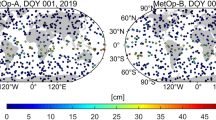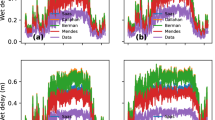Abstract
Water vapor plays an essential role in regulating the earth’s weather and climate, and the tropospheric delays caused by water vapor are one of the error sources in space geodetic techniques. Attributing to the enhancement of the spatiotemporal resolution of satellite observations and the availability of model simulation data, the fusion of the two datasets provides a promising opportunity to improve the performance of tropospheric delay modeling and forecasting. In this contribution, a tropospheric delay network (TropNet) model is developed based on deep learning method to forecast the zenith wet delays (ZWD) by combining information provided by the Geostationary Operational Environmental Satellite-R series and the global forecast system (GFS). The performance of the tropospheric delays predicted from TropNet is assessed with tropospheric products derived from GNSS. The results demonstrate that the TropNet predicted ZWD agree well with the GNSS-derived ZWD, and an accuracy of better than 11 mm is achieved for all the forecast lead times, showing an overall improvement of 15.5% when compared to the GFS ZWD. Moreover, intercomparisons with ZWD derived from radiosondes and Vienna Mapping Functions 3 (VMF3) are performed to further evaluate the performance of the TropNet model. Averaged RMS values equal to 14.9 mm and 13.9 mm are obtained when compared to radiosondes and VMF3. Furthermore, the TropNet model is able to forecast high-quality ZWD up to 6 h at a spatial resolution of 2 km and a temporal resolution of 1 h, which indicates a prospective potential for time-critical applications.












Similar content being viewed by others
Data availability
The GOES-R CMI products are available from https://www.ncdc.noaa.gov/airs-web/search, the GFS datasets are available from https://rda.ucar.edu/datasets/ds084.1/, the GNSS tropospheric products are available from https://www.unavco.org/data/tropospheric/tropo-products/tropo-products.html, the SRTM topography data are available from https://srtm.csi.cgiar.org/srtmdata/, the VMF3 products are available from https://vmf.geo.tuwien.ac.at/, and the radiosonde products are available from https://www.ncei.noaa.gov/products/weather-balloon/integrated-global-radiosonde-archive.
References
Balidakis K, Nilsson T, Zus F, Glaser S, Heinkelmann R, Deng Z, Schuh H (2018) Estimating integrated water vapor trends from VLBI, GPS, and numerical weather models: sensitivity to tropospheric parameterization. J Gerontol Ser A Biol Med Sci 123(12):6356–6372. https://doi.org/10.1029/2017jd028049
Bevis M, Businger S, Herring TA, Rocken C, Anthes RA, Ware RH (1992) GPS meteorology—remote-sensing of atmospheric water-vapor using the global positioning system. J Gerontol Ser A Biol Med Sci 97(D14):15787–15801. https://doi.org/10.1029/92jd01517
Campana K, Caplan P, Halperin DJ, Lapenta B, Lilly S, Lin Y, Penny AB, Saha S, Tallapragada V, White GH (2019) The development and Success of NCEP’s global forecast system. In: 99th American meteorological society annual meeting. AMS
Chen B, Yu W, Wang W, Zhang Z, Dai W (2021) A global assessment of precipitable water vapor derived from GNSS zenith tropospheric delays with ERA5, NCEP FNL, and NCEP GFS products. Earth Space Sci 8(8):e2021EA001796
Compo GP, Whitaker JS, Sardeshmukh PD, Matsui N, Allan RJ, Yin X, Gleason BE Jr, Vose RS, Rutledge G, Bessemoulin P, Broennimann S, Brunet M, Crouthamel RI, Grant AN, Groisman PY, Jones PD, Kruk MC, Kruger AC, Marshall GJ, Maugeri M, Mok HY, Nordli O, Ross TF, Trigo RM, Wang XL, Woodruff SD, Worley SJ (2011) The twentieth century reanalysis project. Q J R Meteorol Soc 137(654):1–28. https://doi.org/10.1002/qj.776
Davis JL, Herring TA, Shapiro II, Rogers AEE, Elgered G (1985) Geodesy by radio interferometry—effects of atmospheric modeling errors on estimates of baseline length. Radio Sci 20(6):1593–1607. https://doi.org/10.1029/RS020i006p01593
Dousa J, Elias M (2014) An improved model for calculating tropospheric wet delay. Geophys Res Lett 41(12):4389–4397. https://doi.org/10.1002/2014gl060271
Dousa J, Elias M, Vaclavovic P, Eben K, Krc P (2018) A two-stage tropospheric correction model combining data from GNSS and numerical weather model. GPS Solut. https://doi.org/10.1007/s10291-018-0742-x
Fulbright JP, Kline E, Gunshor MM, Schmit TJ, Wu X, Pitts K, Pogorzala D (2020) Product maturity process for ABI L1b and CMI products for GOES-R Series. In: Neeck SP, Heliere A, Kimura T (ed) Sensors, systems, and next-generation satellites Xxiv
Gutman SI, Benjamin SG (2001) The role of ground-based GPS meteorological observations in numerical weather prediction. GPS Solut 4(4):16–24. https://doi.org/10.1007/pl00012860
Hadas T, Kaplon J, Bosy J, Sierny J, Wilgan K (2013) Near-real-time regional troposphere models for the GNSS precise point positioning technique. Meas Sci Technol 24(5):055003
Haiden T, Janousek M, Bidlot J, Buizza R, Ferranti L, Prates F, Vitart F (2018) Evaluation of ECMWF forecasts, including the 2018 upgrade. European Centre for Medium Range Weather Forecasts
He K, Zhang X, Ren S, Sun J (2015) Delving deep into rectifiers: surpassing human-level performance on imagenet classification. In: Proceedings of the IEEE international conference on computer vision, pp 1026–1034
Herring TA, Melbourne TI, Murray MH, Floyd MA, Szeliga WM, King RW, Phillips DA, Puskas CM, Santillan M, Wang L (2016) Plate boundary observatory and related networks: GPS data analysis methods and geodetic products. Rev Geophys 54(4):759–808. https://doi.org/10.1002/2016rg000529
Hochreiter S, Schmidhuber J (1997) Long short-term memory. Neural Comput 9(8):1735–1780. https://doi.org/10.1162/neco.1997.9.8.1735
Hofmeister A, Boehm J (2017) Application of ray-traced tropospheric slant delays to geodetic VLBI analysis. J Geodesy 91(8):945–964. https://doi.org/10.1007/s00190-017-1000-7
Kim S, Hong S, Joh M, Song S-K (2017) Deeprain: ConvLSTM network for precipitation prediction using multichannel radar data. arXiv preprint arXiv:1711.02316
Kingma DP, Ba J (2014) Adam: a method for stochastic optimization. arXiv preprint arXiv:1412.6980
Klein SA, Hall A, Norris JR, Pincus R (2017) Low-cloud feedbacks from cloud-controlling factors: a review. Surv Geophys 38(6):1307–1329. https://doi.org/10.1007/s10712-017-9433-3
Lagler K, Schindelegger M, Boehm J, Krasna H, Nilsson T (2013) GPT2: empirical slant delay model for radio space geodetic techniques. Geophys Res Lett 40(6):1069–1073. https://doi.org/10.1002/grl.50288
Landskron D, Boehm J (2018) VMF3/GPT3: refined discrete and empirical troposphere mapping functions. J Geod 92(4):349–360. https://doi.org/10.1007/s00190-017-1066-2
Li X, Long D (2020) An improvement in accuracy and spatiotemporal continuity of the MODIS precipitable water vapor product based on a data fusion approach. Remote Sens Environ. https://doi.org/10.1016/j.rse.2020.111966
Li X, Dick G, Lu C, Ge M, Nilsson T, Ning T, Wickert J, Schuh H (2015) Multi-GNSS meteorology: real-time retrieving of atmospheric water vapor from BeiDou, Galileo, GLONASS, and GPS observations. IEEE Trans Geosci Remote Sens 53(12):6385–6393. https://doi.org/10.1109/tgrs.2015.2438395
Lindstrom S, Schmit TJ, Gunshor MM, Daniels J, Bah K, Goodman SJ (2017) Latest assessment of GOES-R (16) Advanced Baseline Imager (ABI) data quality from an application and training perspective. In: 2017 IEEE international geoscience and remote sensing symposium. IEEE, pp 283–285
Lu C, Zus F, Ge M, Heinkelmann R, Dick G, Wickert J, Schuh H (2016) Tropospheric delay parameters from numerical weather models for multi-GNSS precise positioning. Atmos Meas Tech 9(12):5965–5973. https://doi.org/10.5194/amt-9-5965-2016
Lu C, Li X, Zus F, Heinkelmann R, Dick G, Ge M, Wickert J, Schuh H (2017) Improving BeiDou real-time precise point positioning with numerical weather models. J Geod 91(9):1019–1029. https://doi.org/10.1007/s00190-017-1005-2
National Centers for Environmental Prediction/National Weather Service/NOAA/U.S. Department of Commerce (2015): NCEP GFS 0.25 Degree Global Forecast Grids Historical Archive. Research Data Archive at the National Center for Atmospheric Research, Computational and Information Systems Laboratory. Dataset. https://doi.org/10.5065/D65D8PWK
Paszke A, Gross S, Massa F, Lerer A, Bradbury J, Chanan G, Killeen T, Lin Z, Gimelshein N, Antiga L, Desmaison A, Kopf A, Yang E, DeVito Z, Raison M, Tejani A, Chilamkurthy S, Steiner B, Fang L, Bai J, Chintala S (2019) PyTorch: an imperative style, high-performance deep learning library. In: 33rd conference on neural information processing systems (NeurIPS), Vancouver, Canada
Rabus B, Eineder M, Roth A, Bamler R (2003) The shuttle radar topography mission—a new class of digital elevation models acquired by spaceborne radar. ISPRS J Photogramm Remote Sens 57(4):241–262. https://doi.org/10.1016/s0924-2716(02)00124-7
Reichstein M, Camps-Valls G, Stevens B, Jung M, Denzler J, Carvalhais N, Prabhat (2019) Deep learning and process understanding for data-driven Earth system science. Nature 566(7743):195–204. https://doi.org/10.1038/s41586-019-0912-1
Saastamoinen J (1972) Atmospheric correction for the troposphere and stratosphere in radio ranging satellites. Use Artif Satell Geod 15:247–251
Schmit TJ, Griffith P, Gunshor MM, Daniels JM, Goodman SJ, Lebair WJ (2017) A closer look at the ABI on the GOES-R series. Bull Am Meteorol Soc 98(4):681–698. https://doi.org/10.1175/bams-d-15-00230.1
Schmit TJ, Li J, Lee SJ, Li Z, Dworak R, Lee Y-K, Bowlan M, Gerth J, Martin GD, Straka W, Baggett KC, Cronce L (2019) Legacy atmospheric profiles and derived products from GOES-16: validation and applications. Earth Space Sci 6(9):1730–1748. https://doi.org/10.1029/2019ea000729
Shi J, Xu C, Guo J, Gao Y (2014) Local troposphere augmentation for real-time precise point positioning. Earth Planets Space. https://doi.org/10.1186/1880-5981-66-30
Shi X, Chen Z, Wang H, Yeung D-Y, Wong W-K, Woo W-C (2015) Convolutional LSTM network: a machine learning approach for precipitation nowcasting. In: 29th Annual Conference on Neural Information Processing Systems (NIPS), Montreal, Canada
Sønderby CK, Espeholt L, Heek J, Dehghani M, Oliver A, Salimans T, Agrawal S, Hickey J, Kalchbrenner N (2020) MetNet: a neural weather model for precipitation forecasting. arXiv preprint arXiv:2003.12140
Sun Z, Zhang B, Yao Y (2019) An ERA5-based model for estimating tropospheric delay and weighted mean temperature over China with improved spatiotemporal resolutions. Earth Space Sci 6(10):1926–1941. https://doi.org/10.1029/2019ea000701
Toth C, Jozkow G (2016) Remote sensing platforms and sensors: a survey. ISPRS J Photogramm Remote Sens 115:22–36. https://doi.org/10.1016/j.isprsjprs.2015.10.004
Wilgan K, Hadas T, Hordyniec P, Bosy J (2017) Real-time precise point positioning augmented with high-resolution numerical weather prediction model. GPS Solut 21(3):1341–1353. https://doi.org/10.1007/s10291-017-0617-6
Yang J, Zhang Z, Wei C, Lu F, Guo Q (2017) Introducing the new generation of chinese geostationary weather satellites, Fengyun-4. Bull Am Meteorol Soc 98(8):1637–1658. https://doi.org/10.1175/bams-d-16-0065.1
Zheng F, Lou Y, Gu S, Gong X, Shi C (2018) Modeling tropospheric wet delays with national GNSS reference network in China for BeiDou precise point positioning. J Geod 92(5):545–560. https://doi.org/10.1007/s00190-017-1080-4
Acknowledgements
This work was financially supported by the National Natural Science Foundation of China (Grant 41974029) and the Fellowship of China Postdoctoral Science Foundation (2020M682481). The numerical calculations in this study have been carried out based on the supercomputing system in the Supercomputing Center of Wuhan University. We gratefully acknowledge the NOAA for offering the radiosonde data, the UNAVCO data center for supplying the GNSS tropospheric products, and the NCEP for offering the GFS products. We also would like to thank TU Vienna for providing the VMF3 tropospheric products.
Author information
Authors and Affiliations
Contributions
CXL and YXZ proposed the idea of this manuscript, designed and performed the experiments, and wrote the paper. ZLW and YSZ helped to perform the experiments and write the paper. QYW, ZW, and YXL contributed to the data pre-processing and analyzed the results. YXZ reviewed the manuscript and provided suggestions for improvements. All authors have reviewed the final submitted version of the manuscript.
Corresponding author
Rights and permissions
Springer Nature or its licensor (e.g. a society or other partner) holds exclusive rights to this article under a publishing agreement with the author(s) or other rightsholder(s); author self-archiving of the accepted manuscript version of this article is solely governed by the terms of such publishing agreement and applicable law.
About this article
Cite this article
Lu, C., Zheng, Y., Wu, Z. et al. TropNet: a deep spatiotemporal neural network for tropospheric delay modeling and forecasting. J Geod 97, 34 (2023). https://doi.org/10.1007/s00190-023-01722-4
Received:
Accepted:
Published:
DOI: https://doi.org/10.1007/s00190-023-01722-4




